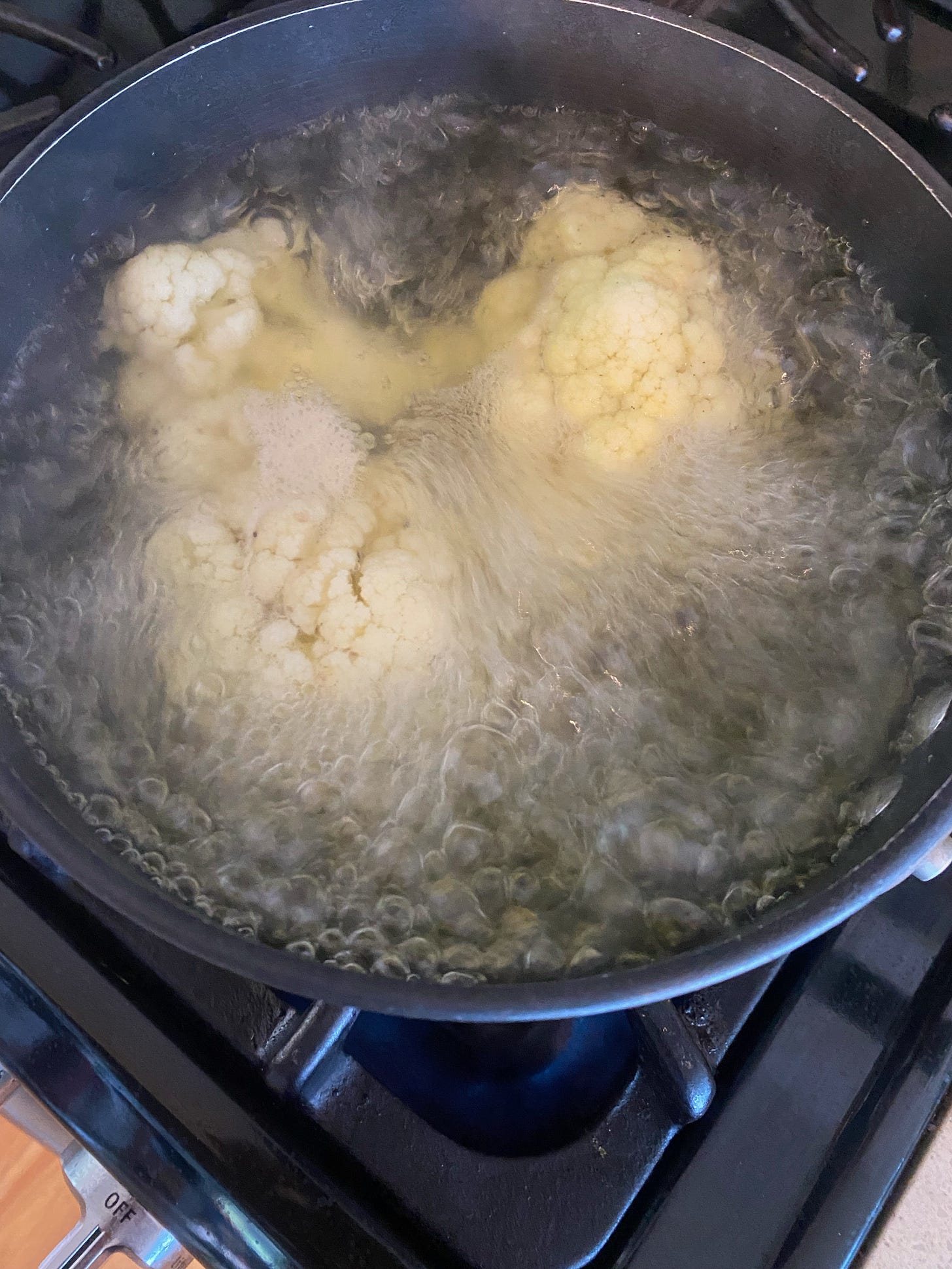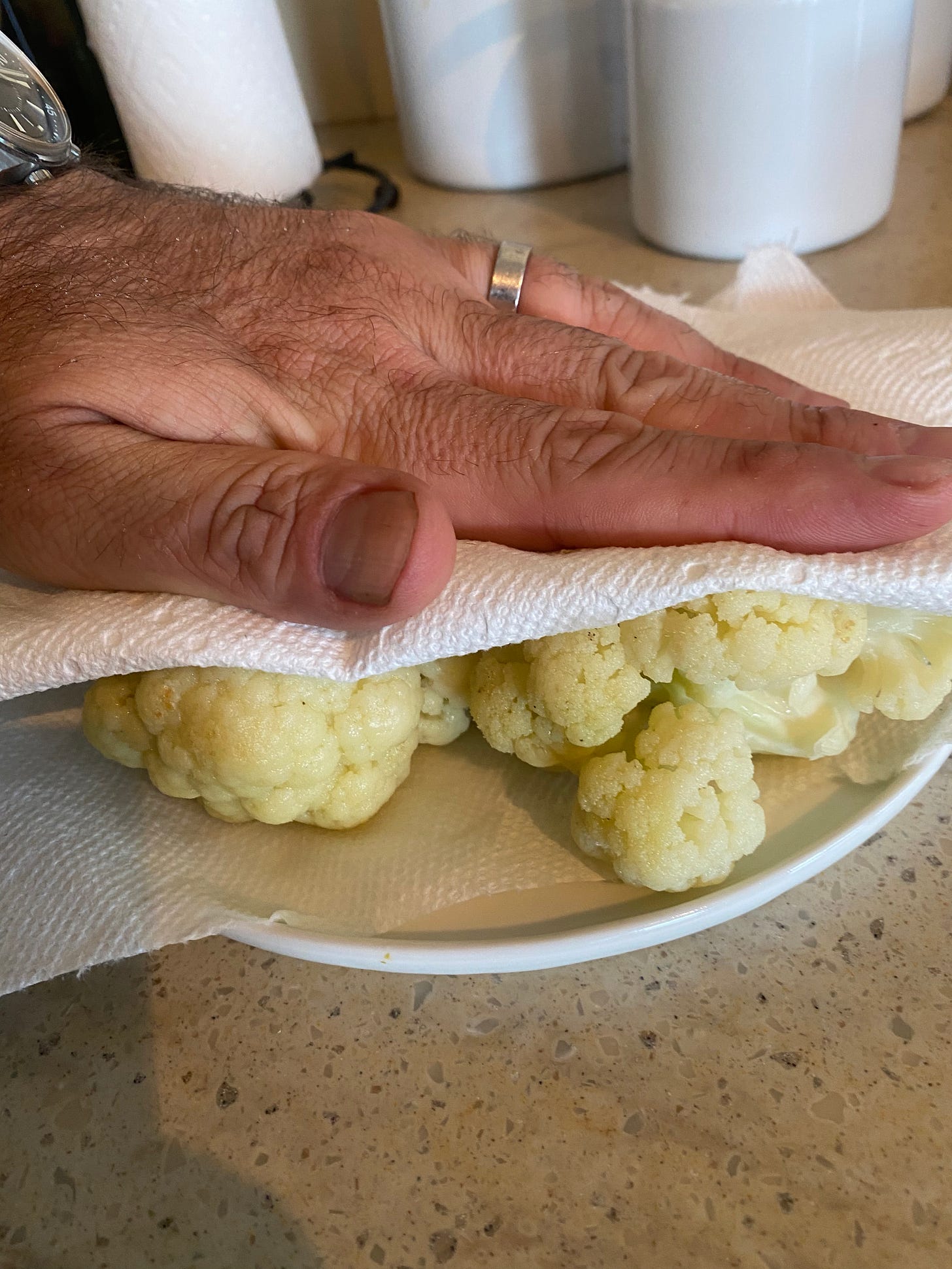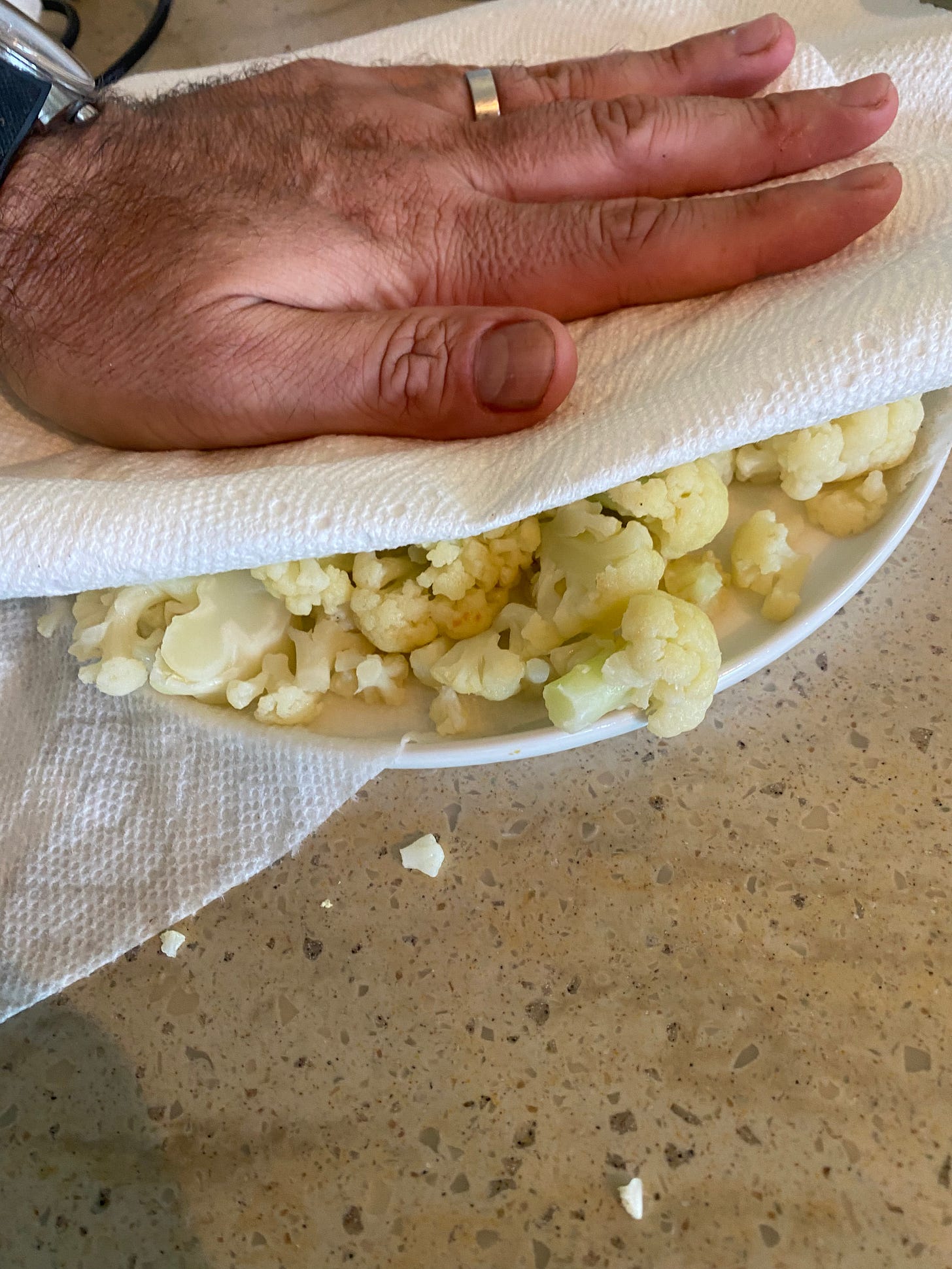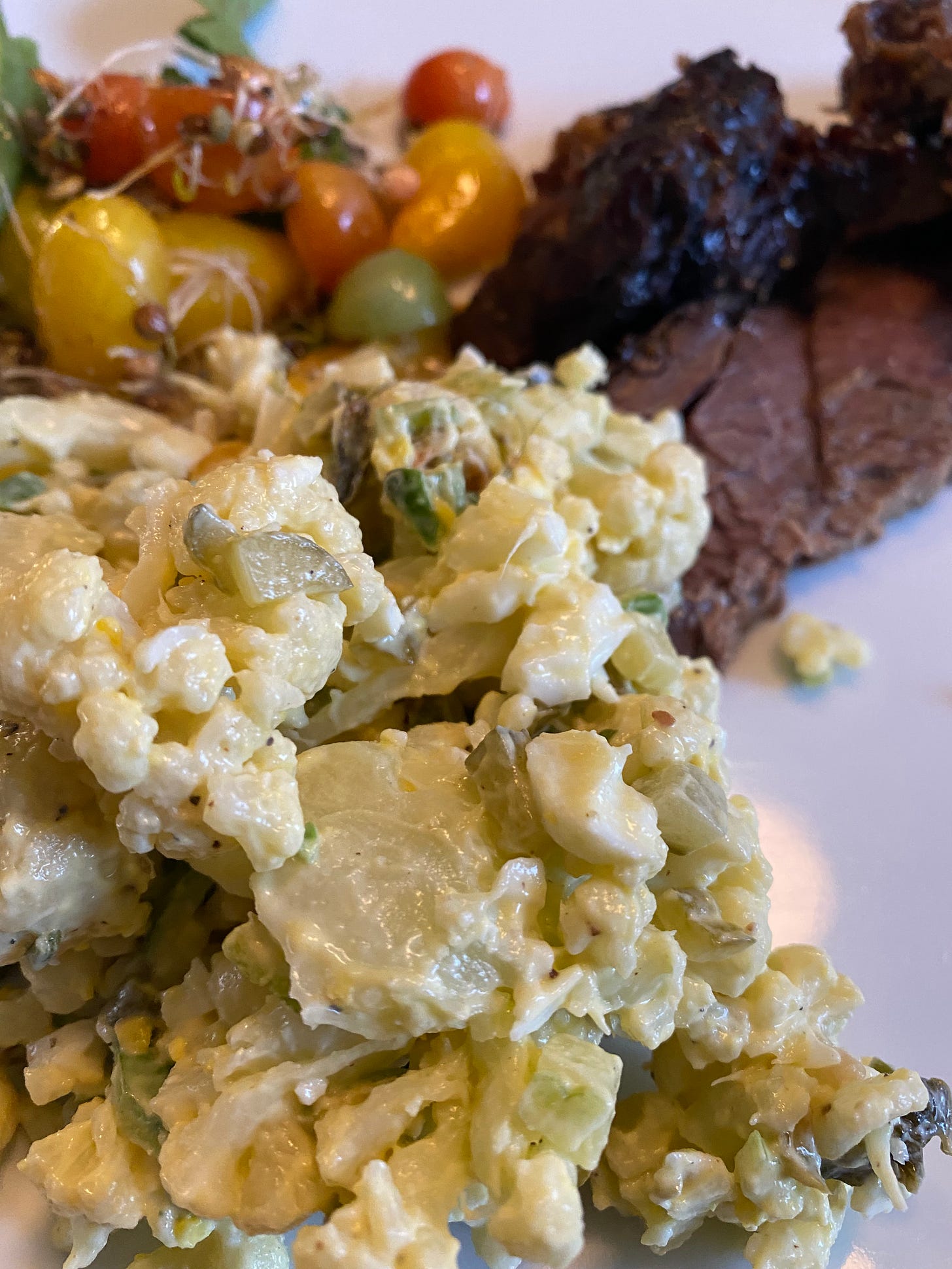You Say Faux-tato, I Say Delicious
Sibling Cauliflower Salads, Buttery Purée, How To Hard-Cook Eggs
Issue #17 is arriving on erev Yom Kippur. For my observant Jewish readers, I hope you have an easy fast. You might consider today’s main recipe a good addition to your break-the-fast menu. Thank you all for signing up and/or subscribing to my weekly newsletter. I appreciate your support and hope that you find some insight and inspiration for your cooking in these lines. If you do, please consider sharing this issue, this newsletter with your friends and family. All the best. —Mitchell

As you might have seen on my Kitchen Sense Instagram feed, Nate and I are just back from a weekend in Toronto, the first time we’ve seen my siblings and their families in the flesh since before the pandemic began and the first time Milo met her Canadian relatives. In addition to the pleasure of just hanging out, there was the pleasure of breaking bread together. (Actually, both of my sisters eat low-carb so we didn’t, in fact, break bread together. We did enjoy some delicious meals, though.) Leslie and Carrie, are excellent cooks. Dinner the day we arrived at Leslie’s was grilled chicken, roasted potatoes (carbs for us), and a cauliflower salad with chopped egg, grilled corn, pickles, and more that mimicked potato salad, but was delicious in its own right. Coincidentally, at Carrie’s the next night, we had grilled chicken (seasoned like souvlaki, this time), roasted potatoes (also just for us), and almost exactly the same cauliflower salad. #siblingsynchronicity
(In case you know me well enough to be wondering, I wasn’t able to see my brother Sheldon, who lives in Guelph, in person because his wife Pauline had a run in with a step stool, but we did have an intra-Canadian Zoom while we were in the same country. Pauline is on the mend; the stool bit the dust.)
It is for carbohydrate-reduction reasons that Leslie and Carrie would both be making potato salad from cauliflower in the first place. Regardless of your diet—mine is full of carbs, as you know if you’ve been following along—the salad is worth making (much like Leslie’s keto crackers in Issue #16, which I highly recommend, too). Besides, who doesn’t love the portmanteau “faux-tato”?
As I contemplated this salad I thought back on previous issues of this very newsletter for which this cauliflower salad was a nexus, of sorts. There is the steamed, par-cooked cauliflower in Issue #3, my homemade mayonnaise and potato salad in Issue #6, and the grilled corn in Issue #15—collectively proof that mastering a few techniques in the kitchen can lead to an array of different dishes.
Before I share my own adaptation of this not-potato salad, a few words of advice from Leslie. First, don’t overcook the cauliflower. I find that the texture of a head of cauliflower varies from one head to another so it’s difficult to give a hard-and-fast rule for just how long to cook it. It also depends how large you’ve cut up your florets and how much of the core you’ve retained. (I like to chop up, and if necessary, peel the core, too.) Whether steaming or boiling cauliflower in salted water, I would suggest between 3 and 5 minutes. Any more and the cauliflower tends toward mush. And be sure to shock the cauliflower in ice water or at least under cold running water to stop the cooking as soon as you remove it from the pot. You want it to retain its bite.
No matter whether you boil or steam your cauliflower to precook it, you must drain it well and then press it firmly between paper towels to remove excess moisture. (Think of pressing tofu.) The cauliflower both retains water and gives off some of its own, and with this dish (as with other cauliflower dishes), it is best to remove as much of that excess liquid as possible before combining.
Finally, I’m giving you a recipe for this salad, obviously, but as with most salads, most recipes, it’s just a guideline. All you really need to make a cauliflower salad is cauliflower and mayonnaise (and even there you might substitute Greek yogurt or sour cream for some of the mayo). I just made this salad again for dinner last night, and I used what I had in the fridge: celery, dill pickle, pickled garlic scapes, wild ramp jam, and bunch of chopped Jimmy Nardello peppers from a prolific plant on our terrace. It was delicious.
RECIPE: “Faux-tato” Cauliflower Salad with Grilled Corn
1 medium head cauliflower (about 1 ¼ pounds), cut into large florets
1 or 2 stalks celery, with leaves, chopped
2 ears grilled corn, kernels removed
3 or 4 scallions or 1 small shallot or a piece of red onion, chopped
1 dill or other pickle, chopped, or 1 or 2 tablespoons of some sort of pickle relish
1 carrot, peeled and grated
2 hard-boiled eggs, peeled and chopped
1/2 to 1 cup mayonnaise, homemade or Hellmann’s (Best), depending on your taste
Salt and freshly ground black pepper
Steam or blanch the cauliflower florets in boiling, salted water for 3 to 5 minutes, depending on how hard and large they are. You want the cauliflower to remain al dente. Remove from the pot into a bowl of ice water to stop the cooking, or else run under cold running water to cool. Drain well. Place a couple of layers of paper towels on a plate and arrange the cooked cauliflower on it. Place more paper towels on top and press firmly with your hand to expel any excess moisture. Don’t destroy the integrity of the cauliflower, but don’t be timid, either. Replace the paper towel if necessary until you’ve removed as much water as possible. Once pressed, cut the cauliflower up into smaller, bite-sized pieces and place in a large mixing bowl.
Add the remaining ingredients, using as much or as little mayonnaise as is your preference. I know too much mayo is unappealing to some, desirable for others. Season with salt and pepper, and mix well. I like to add a bit of pickle juice (whether salty or sweet), too, in order to help loosen the mayo and add flavor, but that’s up to you. Adjust the seasoning to your taste.
Cauliflower of My Eye
Perhaps just based on color alone, but maybe also texture when cooked, cauliflower has become a frequent low-carb substitute for potatoes in other ways, too. (Also pizza crusts, but let’s not go there right now.) I offer this purée from Leslie, as well. If you cook the cauliflower until it is very soft (maybe 7 to 10 minutes of steaming or boiling, or a little more, depending), drain it well, press out the excess moisture, and purée it until very smooth in a food processor or heavy-duty blender with an embarrassing amount of soft butter and a generous amount of salt, you get a delicious puree that doesn’t quite taste like potatoes, but is reminiscent of something the great French chef Joël Robuchon used to serve, and is totally delicious.
Eggsploration
I wrote about poaching eggs in Issue #12, but I haven’t yet shared my technique for hard-cooking eggs, an equally essential and delicious addition to just about anything—sandwiches, tartines, salads, chopped liver, you name it. Of course, with a little salt, hard-cooking eggs are fantastic on their own. #oeufsmayonnaise, anyone?
TECHNIQUE: Hard-Cooking Eggs
Over the years I’ve tried many techniques. Despite periodic declarations of “the perfect technique for cooking eggs,” every few years another article comes out that makes you think there’s something new to learn. In my lifetime of cooking I’ve only used three techniques for any length of time (we are talking years), sequentially. I used to lower eggs with a slotted spoon into boiling water and cooking them for 15 minutes, which is how my mother taught me. These would accurately be known as “hard boiled.” They occasionally had a green ring around the yolk, but we didn’t know any better back then. They peeled pretty easily.
A long treatise on “hard-cooked” eggs in Julia Child & Company changed my technique and my nomenclature. From that point forward I placed eggs in cold water and put them on the stove over a medium-high flame. As soon as the water came to a boil, I turned off the heat, covered the pot, and let them sit for 17 minutes before peeling. This served me well enough for decades and was easy not to screw up.
But a few years back I saw a J. Kenji Lopez-Alt eggsploration on Serious Eats that suggested steaming eggs was the best way to go. He advised to bring a shallow amount of water to a boil in a pot, add the cold eggs in a steamer, cover the pot tightly, and let the eggs steam for 12 minutes. (Now I see he suggests 11 minutes, but having just tried that I will stick to 12 minutes to be sure the yolks are cooked through.) For eggs with jammy yolks I stop them at 8 minutes. Once the time is up, remove the pot from the heat and set it under cold running water to fill and cool the eggs until I can handle them to peel. As an extra assurance of perfect cooking, you can transfer the eggs when done to a bowl of ice water, but I never bother with this step.
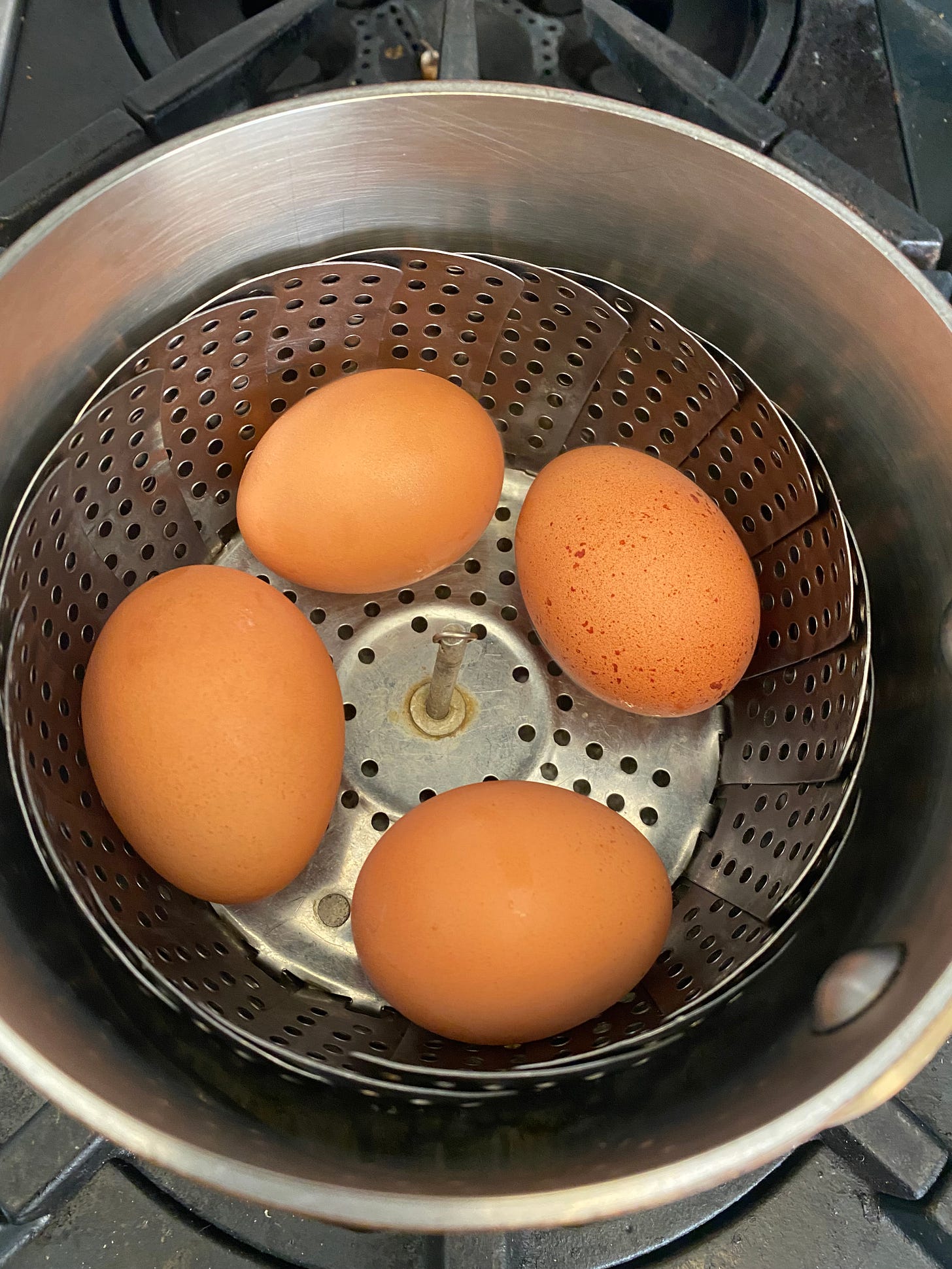
I like this steaming technique a lot. It’s quick. It doesn’t require excess water. It’s precise. And my eggs generally peel easily. I know that fresher eggs are supposed to be harder to peel, but save for cheese and wine, I just can’t recommend to anyone to purposely cook with something that isn’t fresh. And unless you live on a farm and are collecting the eggs yourself (which is something I someday hope to be doing), I think all the eggs you find in the marketplace, even at farmers markets, have been around long enough for them to peel just fine.




